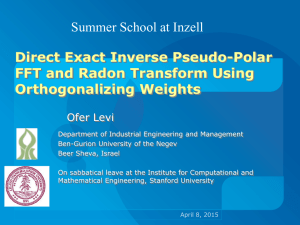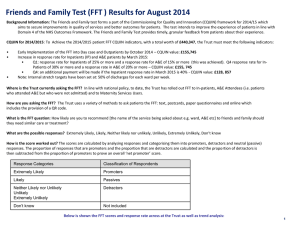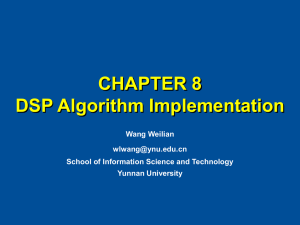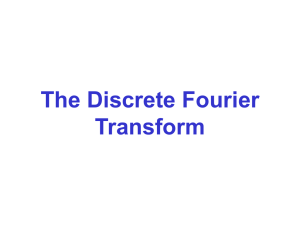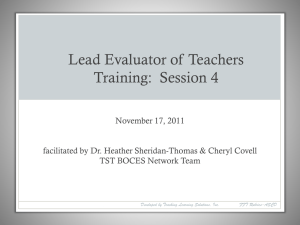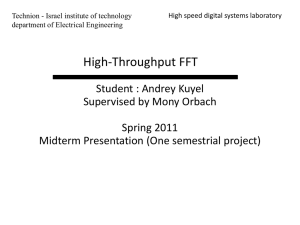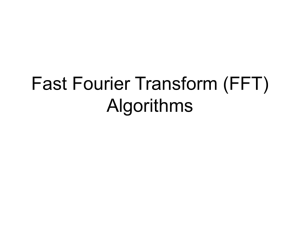Algorithms - University of Michigan
advertisement
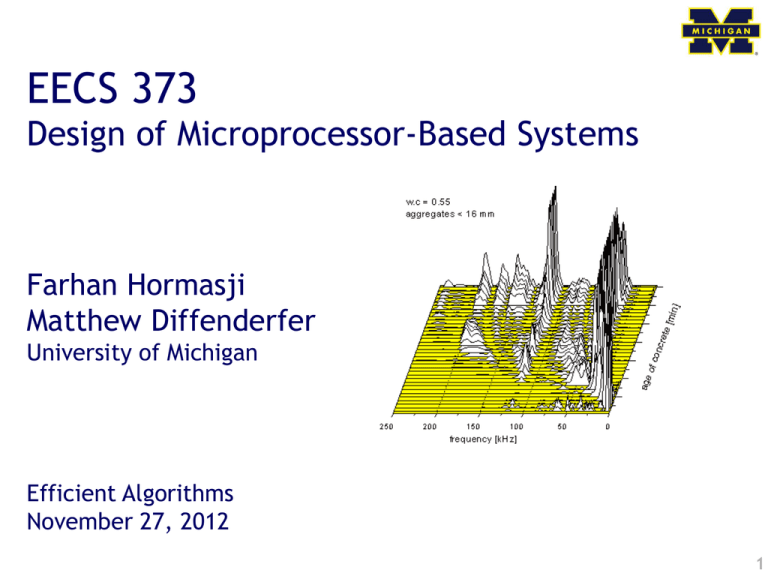
EECS 373 Design of Microprocessor-Based Systems Farhan Hormasji Matthew Diffenderfer University of Michigan Efficient Algorithms November 27, 2012 1 Outline • Overview • DFT algorithms – – – – FFT Cooley–Tukey FFT Bluestein's FFT Goertzel • Edge Detection Algorithms – – – – Canny Sobel Prewitt Roberts Cross • Questions 2 Algorithms What to look for: • Usefulness • Methodology • Implementation Tradeoffs: • Cost • Code Size • Runtime • Availability 3 Outline • Overview • DFT algorithms – – – – FFT Cooley–Tukey FFT Bluestein's FFT Goertzel • Edge Detection Algorithms – – – – Canny Sobel Prewitt Roberts Cross • Questions 4 Discrete Fourier Transform (DFT): Overview • What? – Converts a sampled function from time domain to frequency domain • Use? – DFTs reveal periodicities in input data as well as the relative strengths of any periodic components 5 Discrete Fourier Transform (DFT): Mathematical Interpretation 6 Discrete Fourier Transform (DFT): Applications • Spectral Analysis – Most signals are sinusoidal – DFT tells you frequency, phase, and amplitude components • Frequency Response of Systems – All input and output signals can be represented as cosine waves – By observing change in magnitude and phase, any linear system can be described • Convolution in the Frequency Domain – Convolution in time domain is multiplication in frequency domain – Speed of computation greatly reduced 7 Fast Fourier Transform (FFT): Overview • What? – An efficient algorithm to compute the DFT and its inverse • Why use it? – O(Nlog2N) • Tradeoff – Input data must be a power of 2 – If it’s not, data is either truncated or padded with zeros • Many different types 8 FFT: Cooley-Tukey algorithm • Most common FFT algorithm – Divide and conquer algorithm • Methodology – Breaks up DFT of N samples into N=N1N2 • Benefit – Can be combined with any other DFT algorithm – What Matlab fft function does for optimization 9 FFT: Cooley-Tukey algorithm Methodology 10 Fast Fourier Transform (FFT): Bluestein • Also called chirp z-transform algorithm • Methodology – Expresses DFT as a convolution • Benefit – Computes DFT of arbitrary sizes – Can be used to compute more general transforms • Tradeoff – Only O(Nlog2N) complexity for prime-sized DFTs 11 Fast Fourier Transform (FFT): Bluestein Methodology 12 Goertzel Algorithm 13 Goertzel Algorithm • Tradeoff – O(NM) – N is number of DFT terms, M is the set of DFT terms to calculate • Benefit – Simple structure of algorithm makes it well suited to small processors – More efficient than FFT for small number of frequencies ( if M < log2N) • Applications – Used to recognize DTMF tones produced by buttons on telephone keypad – Call progress (dial tone, busy) 14 Runtime Performance Comparison 15 Runtime Performance Comparison: Matlab 16 Outline • Overview • DFT algorithms – – – – FFT Cooley–Tukey FFT Bluestein's FFT Goertzel • Edge Detection Algorithms – – – – Canny Sobel Prewitt Roberts Cross • Questions 17 Edge Detection Overview • Use – Tool used in image processing – Goal is to identify points in a digital image where image brightness changes sharply or has discontinuities – Reduce amount of data in image so that further image processing may occur – Reduce images to shapes • Applications – Most image processing 18 Edge Detection: Canny • Use – Optimal edge detection • the algorithm should mark as many real edges in the image as possible • edges marked should be as close as possible to the edge in the real image • a given edge in the image should only be marked once • image noise should not create false edges • Benefits – Adaptable to most images – Generally has short runtime, well-suited for real time implementations in FPGAs • Constraints – Size of Gaussian filter – Calibration of thresholds 19 Edge Detection: Canny Methodology • Convolves image with Gaussian filter – To eliminate noise • Uses other types of edge detection to determine intensity gradient vertically, horizontally, and diagonally – 4 filters • Goes through matrix to determine if gradient magnitude is a local maximum based on gradient direction – Determine high and low threshold • Go through image and mark pixel as edge or nonedge based on thresholds 20 Edge Detection: Sobel • Use – Discrete differentiation operator – Computes the gradient of the image intensity • Benefits – Few number of computations – Can be implemented simply in both hardware and software • Tradeoffs – Poor gradient approximation for high frequency variations in image 21 Edge Detection: Sobel Methodology • 2 kernels convolved with original image to calculate gradient in vertical and horizontal direction – Where A is the original image • Compare gradient value to threshold similar to Canny algorithm 22 Edge Detection: Prewitt • Same as Sobel algorithm but with two key differences • The two kernels used have slightly different values • Magnitude and Direction of gradient in Sobel: • Magnitude and Direction of gradient in Prewitt: 23 Edge Detection: Roberts Cross • Use – One of the first edge detectors – Intensity of edges should correspond as close as possible to what a human would perceive • Benefits – Only finds gradient in diagonal direction due to simple kernels, so algorithm has high simplicity • Tradeoffs – Speed of modern computers make this simplicity negligable – Edge detection suffers from sensitivity to noise 24 Edge Detection: Roberts Cross Methodology • 2 kernels convolved with original image to calculate gradient in diagonal direction • Magnitude and direction of gradient found similar to Sobal • Compare gradient value to threshold similar to Canny algorithm 25 Block M 26 Canny 27 Sobel 28 Prewitt 29 Roberts Cross 30 Edge Pixels Detected: Block M 31 Prabal 32 Canny 33 Sobel 34 Prewitt 35 Roberts Cross 36 Edge Pixels Detected: Prabal 37 Blur 38 Canny 39 Sobel 40 Prewitt 41 Roberts Cross 42 Edge Pixels Detected: Blur 43 Gray 44 Canny 45 Sobel 46 Prewitt 47 Roberts Cross 48 Edge Pixels Detected: Grayscale 49 Final Comparison 50 Questions? Comments? Discussion? 51 References • Everything – – Wikipedia Mathworks • DFT/FFT – – – The Scientist and Engineer's Guide to Digital Signal Processing By Steven W. Smith, Ph.D. http://www.robots.ox.ac.uk/~sjrob/Teaching/SP/l7.pdf http://homepages.inf.ed.ac.uk/rbf/CVonline/LOCAL_COPIES/OWENS/LECT4/node3.html • Goertzel – http://www.numerix-dsp.com/goertzel.html • Edge Detection – – http://dasl.mem.drexel.edu/alumni/bGreen/www.pages.drexel.edu/_weg22/can_tut.ht ml http://www.cse.unr.edu/~bebis/CS791E/Notes/EdgeDetection.pdf • Edge Detection Images – – – – Prabal: web.eecs.umich.edu/~prabal/ Block M: www.umich.edu Grayscale: www.colorsimulator.com Blur: www.dreamstime.com (Royalty Free Stock Photos) 52


![Y = fft(X,[],dim)](http://s2.studylib.net/store/data/005622160_1-94f855ed1d4c2b37a06b2fec2180cc58-300x300.png)
